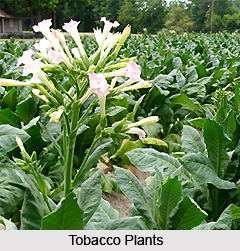Tobacco Plant bears the scientific name Nicotiana tabacum along with other common names. In Bengali it is called tamak, tamaku, tambaku while in Hindi it is called bujjerbhang. In Kannada it is called hogesoppu; pan while in Marathi tobacco is called tamaku, tamaku, tambaku: tamaku, tambaku. In Punjabi it is called tamaku; in Sanskrit dhumrapatra, kalanja, tamakhu; and in Telegu dhumrapatramu, pogaku.
 Tobacco Plant is believed to have originated in northwestern Argentina and Bolivia. It was cultivated in the pre-Columbian era in the West Indies, Mexico, Central America and northern South America. Since its introduction the plant has been cultivated throughout India.
Tobacco Plant is believed to have originated in northwestern Argentina and Bolivia. It was cultivated in the pre-Columbian era in the West Indies, Mexico, Central America and northern South America. Since its introduction the plant has been cultivated throughout India.
Tobacco Plant is a stout, viscid annual which is 1 to 3 m tall having a thick, erect stem and few branches. The leaves of the plant are ovate, elliptic and are usually 12 to 30 cm long. They are generally sessile with a cuneate base or sometimes petiolate with a frilled wing or auricle. The flowers are white to pale red and grow in compound branched panicles with a distinct rachis. The fruit (capsule) of the tree are narrowly elliptic ovoid or orbicular in shape and are usually 1.5 to 2 cm long. The fruits bearing the seeds are spherical or broadly elliptic in its shape and are 0.5 mm long. The Tobacco Plant bears flowers and fruits during the summer months.
Medicinal properties of Tobacco Plant
The leaves of the tobacco plant have been used in traditional Indian medicine as a sedative, antispasmodic and vermifuge. They are also considered antiseptic, emetic and narcotic. A decoction of the leaves is applied locally for muscle relaxation associated with joint dislocation. It is also used to relieve pain and irritation of rheumatic swellings, and to treat strangulated hernia, orchitis and skin diseases. The tribal inhabitants of Surguga District in northeastern Madhya Pradesh warm the leaves of the tree and apply to the testes to treat hydrocele. Even the oil extracted from the leaves is useful for treatment of arthral-gia, gout, lumbago and rheumatism.











